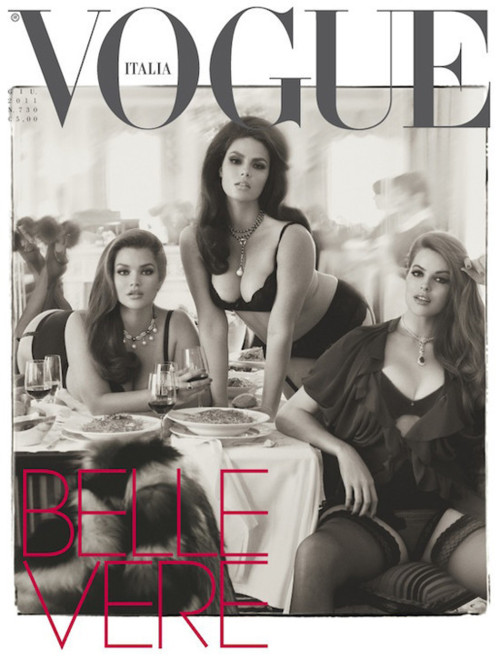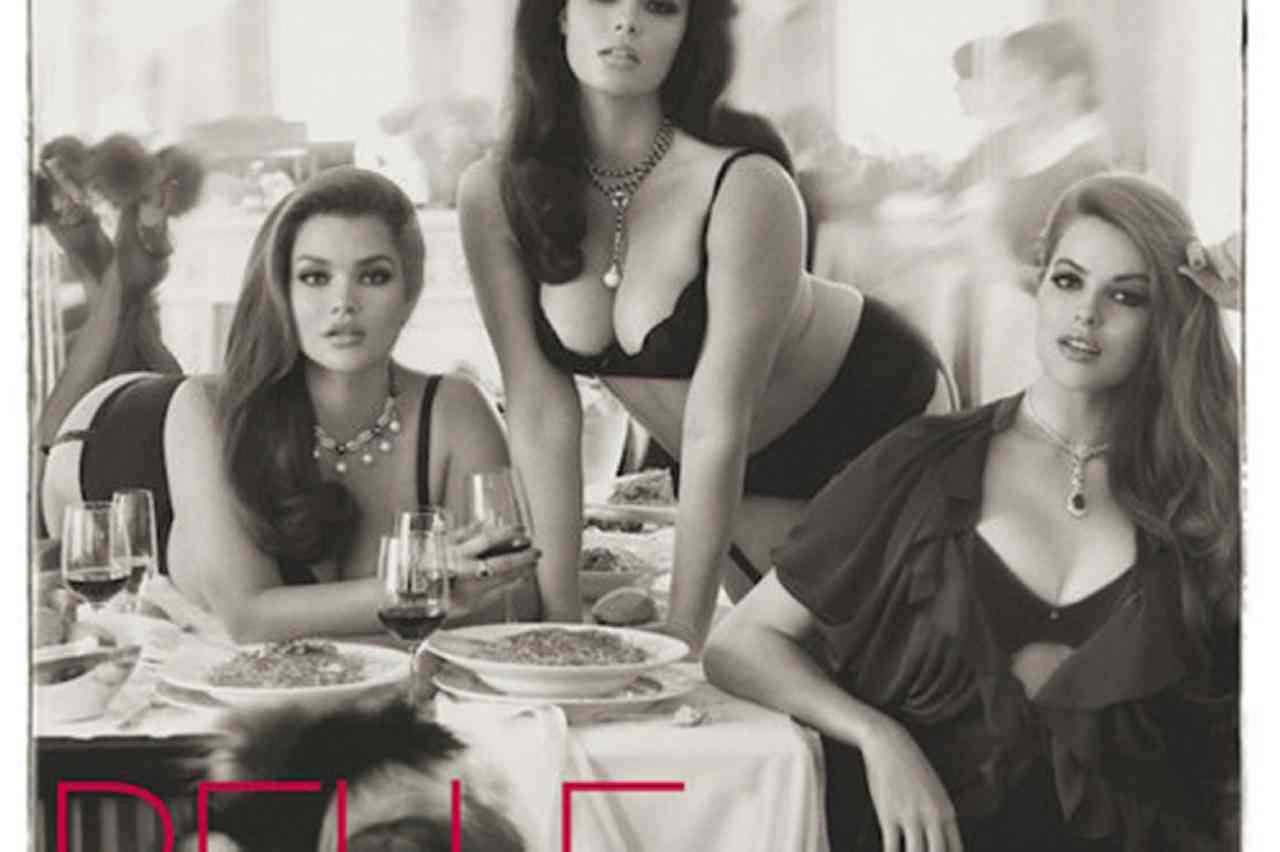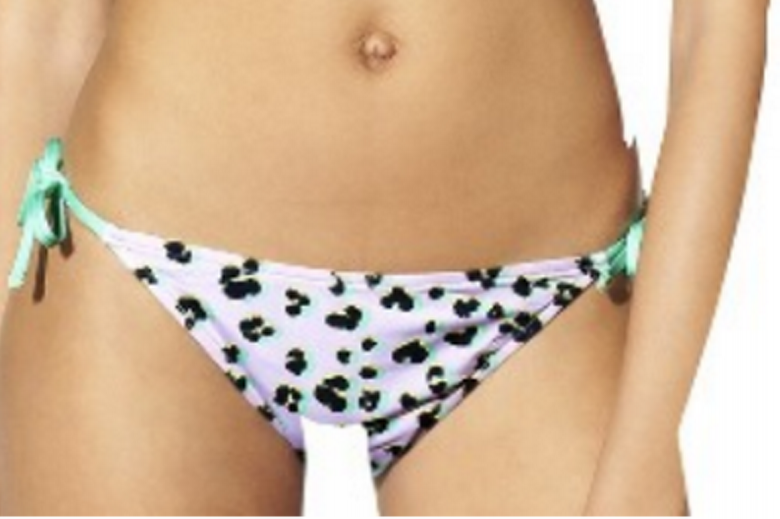If you haven’t heard, Vogue Italia – the Italian version of Vogue magazine, I suppose – is featuring plus-sized models this month. Three beautiful women grace the cover – in lingerie, of course – and on the inside, you see another lovely lady.

In the interest of progress, I am happy to see the non-size-2 figure be highlighted. I think that it can be reaffirming for any woman to see a figure that looks like hers look feminine, desirable and pleasureable. I don’t see myself – past or present – in these women because, honestly, none of them look like me (and I’d imagine this feeling could be the same for any non-Black woman who picks up an Essence or an Ebony) but that doesn’t change the fact that this is going to provide that feeling for some.
That being said… again, in the interest of progress, there are a few things that I’d like to point out, simply because I believe that “plus-size” has become this really loaded phrase that means everything and nothing to women and it makes me wonder if we realize how we inadvertently play into policies and philosophies that are terribly harmful to our own perceptions of ourselves.
The editor-in-chief of the mag, Franca Sozzani, is quoted as saying the following:
WWD: You were initially criticized for your “Black” and “Curvy” pages.
Sozzani: Oh, very much so, because some said it was becoming the ghetto of plus-sized, the ghetto of black, but it’s not true. These are very happy readers, happy that we are looking at them in different ways. In “Curvy,” they are superhappy with their sizes. We help them dress fashionably. We say: It’s pointless for you to buy leggings, take this because this will look good on you. We help them choose. We don’t talk about diets because they don’t want to be on a diet, but it’s not a ghetto. Why should these women slim down? Many of the women who have a few extra kilos are especially beautiful and also more feminine.
“We help plus-sized women dress fashionably.”
Why are they in lingerie? Some, topless altogether? Lingerie can only go so far, and most of us can’t wear it out of the house. I just wonder if it’s really a good idea to attach the “we help big girls dress fashionably” quote to the issue where the women aren’t dressed practically. It also makes me wonder if that’s because there was no other designers who make dresses for women their size, or if it’s because the editors themselves harbor any kind of bias regarding how to properly dress a non-size-2 woman.
I also keep hearing commentary about “real women.” The Vogue Italia cover features real women. Few things in life annoy me more than this, I’ve got to admit. The irony isn’t lost on me that I’m “attacking real women” on a weight loss blog, but understand – I ‘get it’ from both sides on this issue. It’s Mo’Nique Syndrome, also known as “You skinny bitches…” and it’s annoying.
Read my words – I’m not saying that non-size-0 women are not, in fact, real women. I’m saying that the implication that a woman who doesn’t have “curves” – the woman who might look a little more like the magazine than the “average” woman – is not a real woman is troubling to me. When we have to go out of our way to insult someone else in order to more clearly define ourselves and our own positions in life, I have to wonder whether or not we realize the disservice we do to the collective. Besides, a Black woman’s “curves” are different from an Asian woman’s curves… and both are different depending upon whether we’re referring to a woman who either is or is not more fit.
I get it, no one wants to have sympathy for smaller women – especially in a society that already seems to favor them – but as I am someone who writes far too often about compassion when it comes to women and our bodies, I can’t say “that compassion only extends to non-size-2 women.” That’s just not how it works. Proclaiming “realness” as a realm that only exists for non-size-2 women is an obnoxious form of body snarking that only gains traction because it is a warped form of empowerment for women who are often treated like they don’t deserve power. It’s sad, because we all know that attempts to derive some form of comfort or, dare I say it, superiority from disparaging those not like you… are essentially empty. I’d much rather empower all of these women and convince them to move away from putting so much metaphorical weight onto their bodies.
What is body snarking? To put it bluntly, body snarking is the way we comment negatively on other people’s bodies. It can be “My gosh, she’s gained a ton of weight” when she’s gained, in fact, a ton of weight… or it could be “My gosh, she’s so bloated” when it could merely be something as simple as a camera angle. To look at a woman and decide, by her figure, that she couldn’t possibly be a “real woman” denies her the very essence of who she is. And while we could defend it by saying that we reserve those kinds of statements for magazines… we all know that this isn’t the case. We all have heard “only a dog likes a bone” and “real women have curves.” If that woman likes her “bones,” – because “bones” are relative depending upon where you live – then shouldn’t that be enough?
To put it bluntly, if the resolution is that non-size-2s should be free of bodysnarking and negative comments and dehumanizing comments, the same should exist for the rest. Either we exist in a space where body snarking is acceptable, or we don’t. Either allow comments about weight and bodies, or we don’t. Either everyone should have to explain their size (why they eat the way they eat, why they look the way they look, whatever), or no one owes you any damn explanation. Size 2 or otherwise.
Color me skeptical but while I love the photos that appeared in Vogue Italia, I don’t see why these women, in all their unique beauty, couldn’t have held their own standing – or laying – next to a smaller woman. The idea that non-size-2 women need to be sequestered to their own issue, so as to avoid having them stand near smaller women and remind the reader of “just how large they really are,” is also troubling to me. Size acceptance doesn’t come in the form of one issue a year that, despite the editor-in-chief’s comments and their quasi-progressiveness, doesn’t actually include much clothing. It comes in the form of being able to see women of varying sizes standing next to one another, all being complimented well by their clothing – well, about as well as a mag can get it… they don’t do this very well very often for thin women, either – and not being obstructed by some well-crafted set props.
Maybe my lack of familiarity with Vogue Italia is shining through, here. Maybe I’m too hopeful that magazines that try to “push the envelope” and “be progressive” with how they approach bodies that aren’t common in fashion will, in fact, do the daring thing and juxtapose women of different sizes next to one another. Maybe I’m too hopeful that we’ll stop acting like the only motivation for women to lose weight is that they, in fact, hate “fat.” Maybe I’m too hopeful that we’ll see how an environment that tacitly body snarks thin women is still an environment that encourages body snarking.
Maybe, maybe, maybe, baby. Either way, I’m realistic. Vogue Italia can only be as progressive as its readership. So… perhaps the next step is to do what we can to create a space that is more comforting to women of all sizes, and then that’ll create space for this in our magazines. Maybe, indeed.





